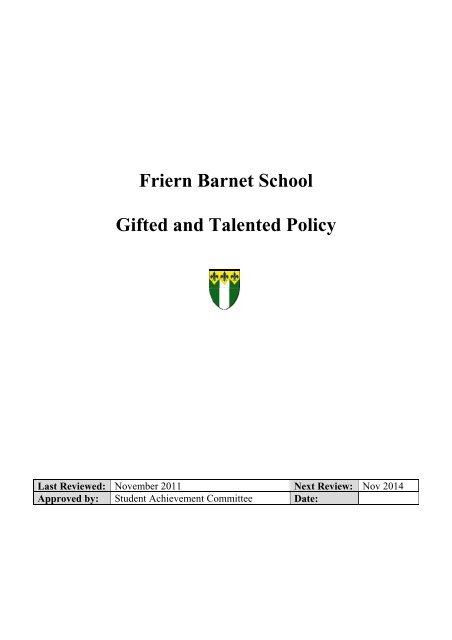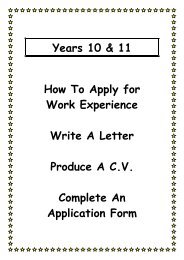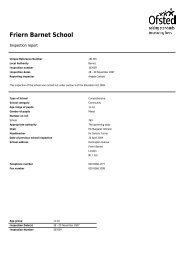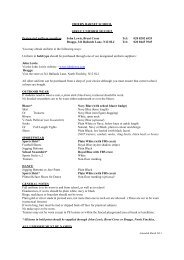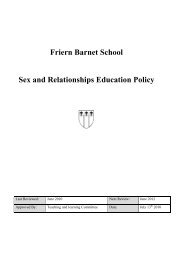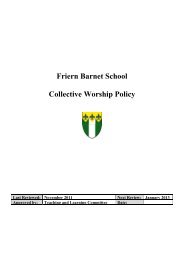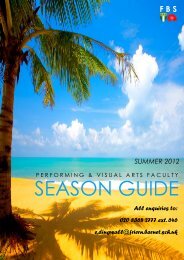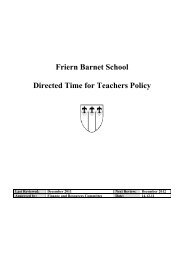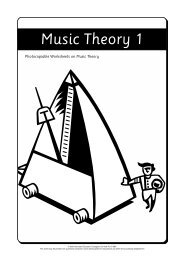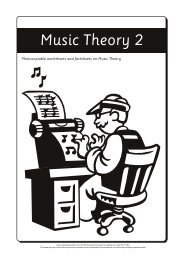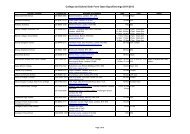Friern Barnet School Gifted and Talented Policy
Friern Barnet School Gifted and Talented Policy
Friern Barnet School Gifted and Talented Policy
You also want an ePaper? Increase the reach of your titles
YUMPU automatically turns print PDFs into web optimized ePapers that Google loves.
<strong>Friern</strong> <strong>Barnet</strong> <strong>School</strong><strong>Gifted</strong> <strong>and</strong> <strong>Talented</strong> <strong>Policy</strong>Last Reviewed: November 2011 Next Review: Nov 2014Approved by: Student Achievement Committee Date:
<strong>Gifted</strong> <strong>and</strong> <strong>Talented</strong> <strong>Policy</strong>Rationale<strong>Friern</strong> <strong>Barnet</strong> <strong>School</strong> is committed to providing an environment which encourages all students tomaximise their potential. The <strong>Gifted</strong> <strong>and</strong> <strong>Talented</strong> <strong>Policy</strong>, although aimed specifically at the more able,is intended to be inclusive in its nature. It is therefore consciously aimed at raising achievementthroughout the school, as well as meeting the needs of the most able. Provision for gifted <strong>and</strong> talentedstudents is the responsibility of all members of staff at <strong>Friern</strong> <strong>Barnet</strong> <strong>School</strong>; by raising the achievementof the more able we aim to raise the achievement of all students within the school.AimsAs a school community we will:• ensure that all students receive an education appropriate to their abilities• provide teaching which makes learning challenging <strong>and</strong> enjoyable• provide higher order thinking <strong>and</strong> questioning skills• stimulate students through extracurricular <strong>and</strong> enrichment activities• support the abilities, personal qualities <strong>and</strong> talents of all children• recognise under-achievement <strong>and</strong> seek to remove it• employ a wide variety of methods of recognition of potential• ensure that the curriculum realises the needs of the most able <strong>and</strong> extends opportunity for all• compile a gifted <strong>and</strong> talented register <strong>and</strong> enter this on the school census• provide appropriate training for staff to ensure that these aims are achievedPractice1. Definitionsa) The term '<strong>Gifted</strong>' refers to those students who are capable of excelling in traditionally academicsubjects such as English or History.b) '<strong>Talented</strong>' refers to those students who may excel in areas requiring practical skills or abilitiessuch as in PE, Drama, or Art.c) ‘Multi <strong>Gifted</strong> <strong>and</strong> <strong>Talented</strong>’ refers to students with high ability in both these areas.d) The term ‘<strong>Gifted</strong> <strong>and</strong> <strong>Talented</strong>’ is not to be understood as referring to the most able children inthe national population. The term should be seen as relative <strong>and</strong> refers to the top 5% to 10% ofany school, regardless of the ability profile of students at the school.2. Identification<strong>Gifted</strong> <strong>and</strong> <strong>Talented</strong> students are identified by making a judgment based on an analysis of varioussources of information including:• test scores (end of key stage levels; examination results)• teacher nomination (based on classroom observation, FFT target grades, discussions withstudents, work scrutiny <strong>and</strong> performances)• parental communication2
3. The <strong>Gifted</strong> <strong>and</strong> <strong>Talented</strong> Registera) Before students join <strong>Friern</strong> <strong>Barnet</strong> <strong>School</strong> in Year 7 staff liaise closely with local primary schools<strong>and</strong> request information about gifted <strong>and</strong> talented students transferring to the school.b) Year 7 students who achieve level 5s in all their KS2 SATs are automatically added to the wholeschool register.c) Additional gifted <strong>and</strong> talented students are identified by subject teachers in consultation withHeads of Faculty, using the subject specific gifted <strong>and</strong> talented identification forms.d) All gifted <strong>and</strong> talented students identified are placed on the whole school gifted <strong>and</strong> talentedregister which is disseminated to all staff.e) Heads of Faculties <strong>and</strong> subject teachers annually review their provision for gifted <strong>and</strong> talentedstudents <strong>and</strong> the register is updated accordingly.4. Provisiona) Within FacultiesStrategies that class teachers will employ to meet the needs of the gifted <strong>and</strong> talented include:• differentiation within subject areas to develop students’ resilience <strong>and</strong> resourcefulness• the development of independent learning by allowing students to organise their own work,carry out tasks unaided, evaluate their work <strong>and</strong> become self-critical• the coherent management of student groupings (whether mixed ability groups or ability sets)<strong>and</strong> recognition that, whilst there may be a higher concentration of gifted <strong>and</strong> talented studentsin some groups, there will be students who have gifts <strong>and</strong> talents in all groups• the provision of enrichment/extension activities <strong>and</strong> tasks• mentoring <strong>and</strong> additional provision for students of exceptional ability (including opportunitiesprovided by external agencies)b) Across Key StagesThe pastoral teams at <strong>Friern</strong> <strong>Barnet</strong> <strong>School</strong> will provide opportunities <strong>and</strong> support for gifted <strong>and</strong>talented students including:• motivational assemblies to support the achievement of gifted <strong>and</strong> talented students• Aim High Evenings for parents• specific materials to support learning• mentoring opportunities• regular Key Stage Manager challenges• enrichment <strong>and</strong> extra-curricular opportunities• devising specific student action plans <strong>and</strong> encouraging parental involvementc) Through Extra-Curricular ActivitiesWe encourage all subjects to offer extra-curricular activities on a regular basis <strong>and</strong>, although thesebenefit all students, they are particularly apt for ensuring that students who have potential in theseareas are given opportunities to practise <strong>and</strong> extend their skills. These activities include:• enrichment days• residential experiences• school clubs• musical <strong>and</strong> sporting activities.• performing arts events3
d) Through Partnership with ParentsTo maximise the effectiveness of the gifted <strong>and</strong> talented programme parents will be fully informed ofstudent data <strong>and</strong> staff recommendations for their children to be added to the whole school gifted <strong>and</strong>talented register.They will be also be informed of the school’s strategies <strong>and</strong> opportunities for gifted <strong>and</strong> talentedstudents.Parents can request for their children not to be included on the whole school gifted <strong>and</strong> talentedregister if they so wish.5. Coordination <strong>and</strong> MonitoringThe <strong>Gifted</strong> <strong>and</strong> <strong>Talented</strong> Coordinator has overall responsibility for ensuring that:• the policy is implemented• effective monitoring of the progress of gifted <strong>and</strong> talented students takes place• the professional development programme for staff includes relevant aspects of gifted <strong>and</strong>talented provision• the provision is reviewed <strong>and</strong> reported to SLT <strong>and</strong> Governors on an annual basisGovernorsThe Governing Body will ensure that gifted <strong>and</strong> talented provision within the school is monitoredregularly by the Student Achievement Committee.Appendix 1:Example of subject specific identification criteria for <strong>Gifted</strong> <strong>and</strong> <strong>Talented</strong> students – English <strong>and</strong> DanceAppendix 2:Example of proformas that Heads of Faculty have completed outlining their existing provision <strong>and</strong>ongoing vision for <strong>Gifted</strong> <strong>and</strong> <strong>Talented</strong> students – English <strong>and</strong> Dance4
G & T Identification FormName:Form:Subject: ENGLISHName of Subject Teacher:Date of Referral:Evidence of Departmental Criteria Met;Speaking <strong>and</strong> Listening: This <strong>Gifted</strong> <strong>and</strong> <strong>Talented</strong> Student:uses complex language structuresappreciates subtleties such as nuance or implicationutilises a repertoire of language greater than those of their peersexplores using a variety of language purely for enjoymentis a persuasive debateruses language to manipulate people <strong>and</strong> situationslistens, responding to <strong>and</strong> building upon the contributions of othersReading: This <strong>Gifted</strong> <strong>and</strong> <strong>Talented</strong> Student:selects texts to read in advance of their age, <strong>and</strong> persists with difficult textsrefers to dictionaries <strong>and</strong> thesauruses to confirm ideasuses high order thinking skills such as evaluation or synthesisrecognises, analyses <strong>and</strong> questions ambiguities within a textutilises styles they have read in their own writinghas curiosity <strong>and</strong> the desire to explore textsreads for enjoymentWriting: This <strong>Gifted</strong> <strong>and</strong> <strong>Talented</strong> Student:utilises a variety of structures within their own writingis prepared to experiment with a variety of writing styleswrites conciselymanipulates the emotions of the readershows creativity <strong>and</strong> originality in their ideasReferred to HoFTo be tracked by: ……………………………………………………………………5
G & T Identification FormName:Form:Subject: DANCEName of Subject Teacher:Date of Referral:Evidence of Departmental Criteria Met;A <strong>Gifted</strong> <strong>and</strong> <strong>Talented</strong> student may:Performing• Perform techniques <strong>and</strong> skills with consistent precision, control <strong>and</strong> fluency• Show an underst<strong>and</strong>ing of projection <strong>and</strong> sensitivity towards other dancers <strong>and</strong> the audience• When leading others in rehearsal practices they can apply basic health <strong>and</strong> safety rules, rehearsal techniques <strong>and</strong> compositionalideas consistently• They plan ways to improve their own <strong>and</strong> others’ performance <strong>and</strong> act on these decisions in order to bring about theimprovements• When adapting <strong>and</strong> responding to changing circumstances <strong>and</strong> other performers, they maintain the quality of a performanceChoreographing• When planning their own <strong>and</strong> others’ work they use imaginative ways to solve problems, overcome challenges <strong>and</strong> entertainaudiences• They draw on what they know about composition in response to a stimulus to create original <strong>and</strong> interesting movements <strong>and</strong>dances• When working in a group they can use what they know about their own <strong>and</strong> others’ strengths <strong>and</strong> weaknesses to create asuccessful outcomeAnalysing• They can show that they underst<strong>and</strong> the elements of dance by comparing <strong>and</strong> commenting on skills, techniques <strong>and</strong> ideas usedin their own <strong>and</strong> others’ work• They can use this underst<strong>and</strong>ing to improve their own <strong>and</strong> others performance• They are able to analyse a professional work <strong>and</strong> point out the features <strong>and</strong> elements of dance• They take on different roles within an activity, showing an ability to organise <strong>and</strong> communicate effectively, <strong>and</strong> applying rulesfairly <strong>and</strong> consistently or adhering to the conventions <strong>and</strong> codes of conduct for activities, e.g. Warm-up, teaching a sequence,leading a dance club• They can show that they underst<strong>and</strong> the elements of dance by comparing <strong>and</strong> commenting on skills, techniques <strong>and</strong> ideas usedin their own <strong>and</strong> others’ work• They can use this underst<strong>and</strong>ing to improve their own <strong>and</strong> others performance• They are able to analyse a professional work <strong>and</strong> point out the features <strong>and</strong> elements of danceThey take on different roles within an activity, showing an ability to organise <strong>and</strong> communicate effectively, <strong>and</strong> applying rules fairly <strong>and</strong>consistently or adhering to the conventions <strong>and</strong> codes of conduct for activities. eg. Warm-up, teaching a sequence, leading a dance club.Referred to HoFTo be tracked by: ………………………………………………………………….6
<strong>Gifted</strong> <strong>and</strong> <strong>Talented</strong>English DepartmentWhat is done at the moment for G&T students in terms of thecurriculum?• In class, G&T students are provided for through differentiation, both with regards tomaterials provided <strong>and</strong> expectations.• Extension activities are built into lessons <strong>and</strong> targets both verbally <strong>and</strong> on written workare designed to stretch more able pupils.• We now set Year 9 in the same way we set for key stage 4, with two top sets <strong>and</strong> 4mixed ability – this enables staff to focus more on challenging G&T students withinthese sets.How G&T students are tracked <strong>and</strong> monitored?• Names are provided by subject teachers <strong>and</strong> the list is updated on an annual basis.• G&T students are tracked <strong>and</strong> monitored using the same rigorous assessmentprocedures that are applied to all other students.• Half-termly levels are inputted into a central spreadsheet that all department memberhave access to.What is done for G&T students in terms of extracurricular activities?• Year 7 G&T students will be invited to participate in an after school writer’s project inthe Autumn term. The outcome is a published book of their best pieces of work.• A team of Year 7 G&T spellers will again be entered for The Times Spelling Bee laterthis year.• A Year 11 poetry trip targeting students predicted a B or above is to take place laterthis year.• A reading club will once again take place later in the year where G <strong>and</strong> T students fromall year groups will have the opportunity to read <strong>and</strong> evaluate novels nominated for theCarnegie award.What is your vision for the provision for G&T students in the comingyear?• Continue to ensure teacher awareness of G&T students in their classes to informdifferentiation• Setting at Year 9 to target the more able.• Continued extra-curricular provision in the form of appropriate trips.7
<strong>Gifted</strong> <strong>and</strong> <strong>Talented</strong>Dance DepartmentDance Extension Task StrategiesThe following strategies are used to provide G & T students opportunity to continue to developskills:• teaching <strong>and</strong> choreographing others• assessing others• challenging movement vocabulary• challenging choreographic devices• preparing a warm-up or a sequence of dance to teach the class• teaching a year group lower or even higher than their own• helping an SEN or less able student in the class.How G&T students are tracked <strong>and</strong> monitored?• students are identified based on 3 elements: performance skill, choreographic skills <strong>and</strong>theoretical underst<strong>and</strong>ing• at the end of each term the dance teachers will review the G&T Dance register <strong>and</strong> addany students identified as G&TWhat is done for G&T students in terms of extracurricular activities?G&T students are encouraged to take part in performance opportunities throughout the year<strong>and</strong> are given leadership roles in these performance opportunities. In addition, the followingextra-curricular activities take place:Enhanced Arts Programme (EAPs)• Parents/Carers complete an application form for students to join this programme <strong>and</strong>students are invited to audition• Dance run a 30 minute session for EAPS at lunch-time once a week. The purpose is todevelop their dance skills <strong>and</strong> work towards a performance<strong>Friern</strong> <strong>Barnet</strong> <strong>School</strong> Dance Company• termly audition• students on the G&T list are invited to audition to join the FBS Dance Company• the company rehearses every Tuesday evening <strong>and</strong> perform at <strong>Friern</strong> <strong>Barnet</strong> <strong>School</strong>’seventsStep into Dance break dance group.• a 2 hour session is run every Tuesday after-school by a break dance specialist• the session is open to all students, however dance teachers identify G&T students whowould benefit from this dance style <strong>and</strong> invite them to attend• the session is free for students <strong>and</strong> open to boys <strong>and</strong> girls• the group performs at <strong>Friern</strong> <strong>Barnet</strong> <strong>School</strong> <strong>and</strong> Step into Dance eventsThe Pixl Club Partners in Excellence dance project.• G&T dance students were invited to attend an audition <strong>and</strong> form a dance group led byone of the dance teaching staff at a weekend performance project <strong>and</strong> performing atthe PIXL Celebration Event at the Queen Elizabeth Hall8
What is your vision for the provision for G&T students in the comingyear?• create a formal G&T link with the partner schools <strong>and</strong> run a joint project/opportunity;this could be a workshop or sharing of performance work• look for a project that allows G&T to relate to the professional world of dance• link with other schools e.g. several Junior schools have asked for dance leaders to runsessions at their school.• each G&T students has a 15 minute meeting with a dance teacher to write their G&TDance plan with targets to meet <strong>and</strong> achieve in class or through extra- curricular• provide an early entry GCSE or BTEC dance provision• run a dance leaders course or be part of a Sports Leaders course with the PEdepartment• build on the partnership with Woodhouse A level course to ensure G&T students canaspire to auditioning for the course at KS5• identify funding opportunities to support the G&T provision for dance at FBS• student voice input to improve the department9


